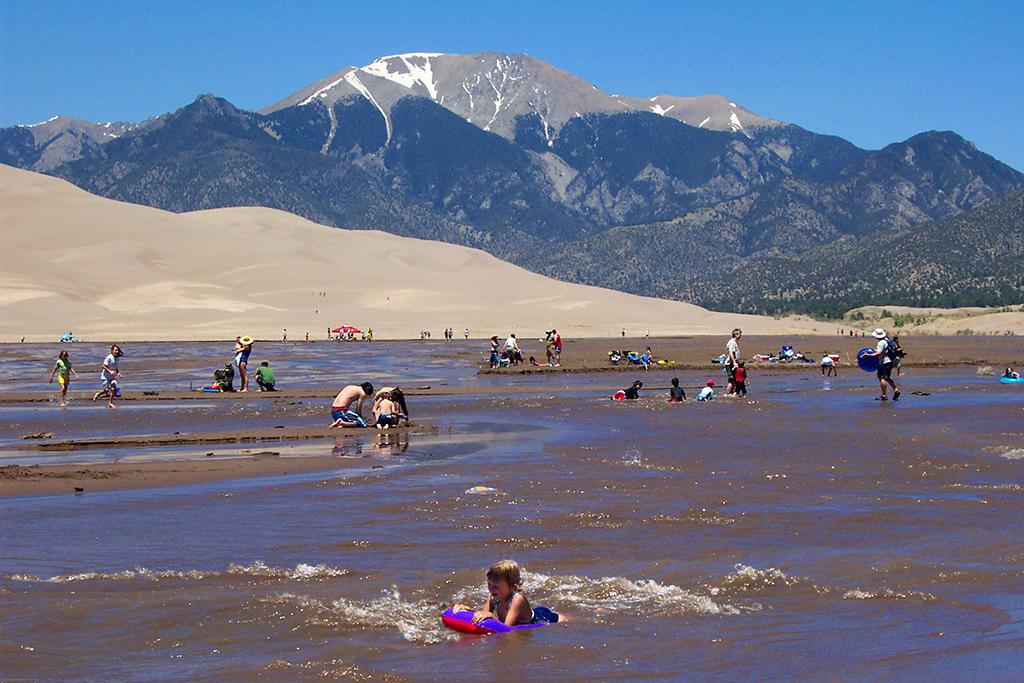Most of the images you may see of Great Sand Dunes National Park and Preserve are of people having fun playing in Medano Creek or sandboarding down a dune during the summer season. But different seasons change the temperature and can alter the landscape.
Spring (March, April, May)

Sandhill cranes linger in early spring before heading onward, Great Sand Dunes National Park and Preserve / NPS file
Spring weather is “volatile,” according to the National Park Service. Some days will be sunny and clear, other days will be extremely windy, and there might even be a blizzard with deep snow, as winter still maintains a slight grip. March sees an average high of 47oF (8oC) and an average low of 21oF (-6oC). April’s average high temperatures reach around 56oF (13oC) with lows around 28oF (-2oC), so things are starting to warm up … sort of. By April, Medano Creek has melted, but tiny biting gnats (“no-see-ums”) begin their onslaught. By May, the creek’s flow is usually at its heaviest and temperatures are moderate, in the 60s and 70s (oF). Late May (and early June) is the best time to experience “surge flow,” where waves up to about 20 inches (50 cm) high flow down across the sand and children with inflatable toys can float the waves. This season also sees huge Spring Break crowds, with long traffic lines, overflowing parking lots, crowding near the creek, and the in-park and area campgrounds filled to capacity.
Summer (June, July, August)

Summer fun at Medano Creek, Great Sand Dunes National Park and Preserve / NPS file
Early summer ensures a warmer Medano Creek, perfect for playing in and near the water. Temperatures range from a high of 76oF (24oC) during the day, to a low of 45oF (7oC) at night. The creek is extremely popular during this time of year.
As summer continues, creek flow retreats and lessens. Mosquitoes emerge in large numbers and remain for 4-7 weeks, depending upon Medano Creek’s water level. Eventually, the creek will dry up at the visitor center location but continue a slight flow (1 in / 2.5 cm) along the eastern edge of the dunefield. Average highs are in the low 80s( oF) during the day, but air temperatures are different from sand temperatures, which can reach 150oF (37.8oC). July is the warmest summer month, with August coming in a close second. Afternoon thunder showers are common, so be prepared for wind (more than the usual wind always seems to blow at the dunes), heavy rain, and lightning. If you are a night sky enthusiast, the Milky Way will appear an hour-and-a-half earlier after sunset in August.
Fall (September, October, November)

Golden cottonwood trees, dunes, and Cleveland Peak, Great Sand Dunes National Park and Preserve / NPS - Patrick Myers
September has some of the best weather of the year, with an average high of 71oF (21.7oC) and a low of 42oF (5.6oC). Most of the days are sunny and calm. The dunes remain hot, though, so it’s a good idea to wear protective footwear. Aspen trees begin to turn gold and there might be a dusting of snow.
As fall progresses, the temperatures turn colder with averages of 46oF (7.8oC) during the day and 20oF (-6.7oC) at night. Sandhill cranes on their annual migration return to the valley in October and early November. Cottonwood trees have turned gold by October. The park becomes quieter and elk and pronghorn start grazing the park’s grasslands, usually during mornings and evenings. Visitation drops off considerably, although Thanksgiving Day entertains large crowds. Hunting season begins, so bright clothing is recommended for visitors hiking in the mountains.
Winter (December, January, February)

A February winter's day at the dunes, Great Sand Dunes National Park and Preserve / Rebecca Latson
By December, Medano Creek has frozen over and the snowfall is heavier and lasts longer. The sand is partially frozen, making it firmer and easier to hike up and down the dunes.
January is usually the coldest month, with average highs in the low 30s (oF) to the teens, and average lows in the single digits or even below zero degrees F. While most days are sunny and calm, blizzards are possible, with snow falling on the dunes about once per week. Most of the hiking trails in the mountains are snow covered and while high-clearance 4WD vehicles can usually make it to the Castle Creek Picnic Area, the remainder of Medano Pass Primitive Road is closed for the season.
Snow lingers in places during February, a slightly warmer month than January. There might even be a few snowstorms, too. February heralds the arrival of sandhill cranes. These birds will reside in the valley for about 6-8 weeks. There’s plenty of solitude and very few people. Medano Creek remains frozen and snow covered. Elk and pronghorn roam the landscape during early morning and evening hours.
You can keep abreast of Medano Creek current and forecast flows as well as weather information and forecasts and Medano Pass Primitive Road conditions to plan for your Great Sand Dunes visit any season of the year.





